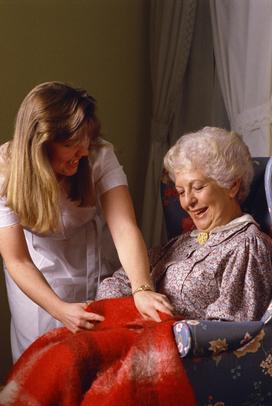
How to Start a Non-Medical Senior Care Business

According to MetLife’s 2010 Market Survey of Long-Term Care Costs, the average cost per year for a nursing home, semi-private room is $74,825. With the growing costs of full-time care, some families are keeping Mom or Dad at home and getting extra help during the day or for extra assistance. If you enjoy helping others and appreciate the challenges of caring for the elderly, a non-medical senior care business will suit you perfectly.
Step 1
Determine what services you will offer. The first step is to decide what you, or those you hire, are physically capable of providing. Will you offer only a visit and meal preparation? Other services to consider include light cleaning, reminders to take medication, feeding pets, accompanying the client to social functions, companionship and transfer assistance.
Step 2
Obtain the necessary permits and licensing. You will need to contact the Department of Aging and Disability Services (DADS). They will require that you take online training, submit a license application, provide any requested documentation and get approval from DADS.
>Step 3
Obtain training in CPR. While you are waiting for approval from DADS, it is a good idea to get CPR training. Family members tend to feel more comfortable leaving their loved one with someone who has emergency training and knows how to respond in a tense situation.
Step 4
Apply for approval to receive funds from Medicare and Medicaid. Some of your clients will have Medicaid funds to use, having applied for a  waiver. Typically the client will already have this in place and approved when she contacts you for services. It is smart to get familiar with the process in case the senior requires assistance regarding whom to contact for financial help. While you can serve seniors without obtaining this approval, you cannot serve those who wish to use these funds for their care.
waiver. Typically the client will already have this in place and approved when she contacts you for services. It is smart to get familiar with the process in case the senior requires assistance regarding whom to contact for financial help. While you can serve seniors without obtaining this approval, you cannot serve those who wish to use these funds for their care.
Step 5
Obtain insurance. Although most of the homes where you will work most likely have homeowner’s insurance, it is a good idea to obtain an umbrella insurance policy that will cover you personally in case of a lawsuit or injury. Include the exact services you’ll be offering, if you’ll be driving your senior clients in your personal automobile or theirs, and how many hours a week you plan to work. If you hire additional employees, you may need more insurance. You will also want to get bonded, which covers your company in case an employee steals or damages property while working for you.
Step 6
Create a name and logo. Your next step is to come up with a name that indicates your company’s mission. If your main focus is on caring for others, then try to work the word “care” into your name. If your greatest desire is to allow the elderly to remain in their own homes, then you might want to add the word “home” or even “hearth.” Any logo ideas should come from the name. A name such as “Home Hearts” would be well-suited to an image of a house with a little heart-shaped sun over it and the words in a simple text. A good graphic artist can provide you with several samples to help you decide.
Step 7
Set your prices. Since senior care is a service business, you won’t have a lot of overhead. Driving to locations and advertising are the two big costs. To decide what to charge, figure out what you would like to make per hour, what your minimum number of hours are per job and add in fuel costs and divide advertising costs throughout the year. You may have to guess on some of these costs at first. For example, if you want to make $12 and hour and work at least four hours, then you would offer a half-day option for $63 ($12 per hour, $5 gas roundtrip, $10 advertising). Decide if you will offer a discount for regular bookings, multiple days in the same week and the maximum distance you are willing to travel.
Step 8
Create printed material. If you can afford it, hire a desktop publisher to create a brochure, business cards and fliers for your business. You want to present a professional image.
Step 9
Distribute material. Take the brochures to doctor’s offices, particularly doctors who specialize in geriatrics. Speak to the doctor about your new business, what services you provide and ask to leave a few brochures. Next, take out a city map and locate the areas where you would like to provide your service. Place fliers in the newspaper boxes in these neighborhoods. You should also hang fliers in public locations in the area, such as libraries, laundromats and grocery stores.
Step 10
Set up a calendar. As you begin to receive calls, keep a very accurate booking calendar of where you are scheduled and on what days. Beauty supply stores offer appointment calendars that are perfect for this use.
Source: Chron.com
 |
| 6183 Paseo Del Norte #100 Carlsbad, CA 92011 | DRE#01520947 |


